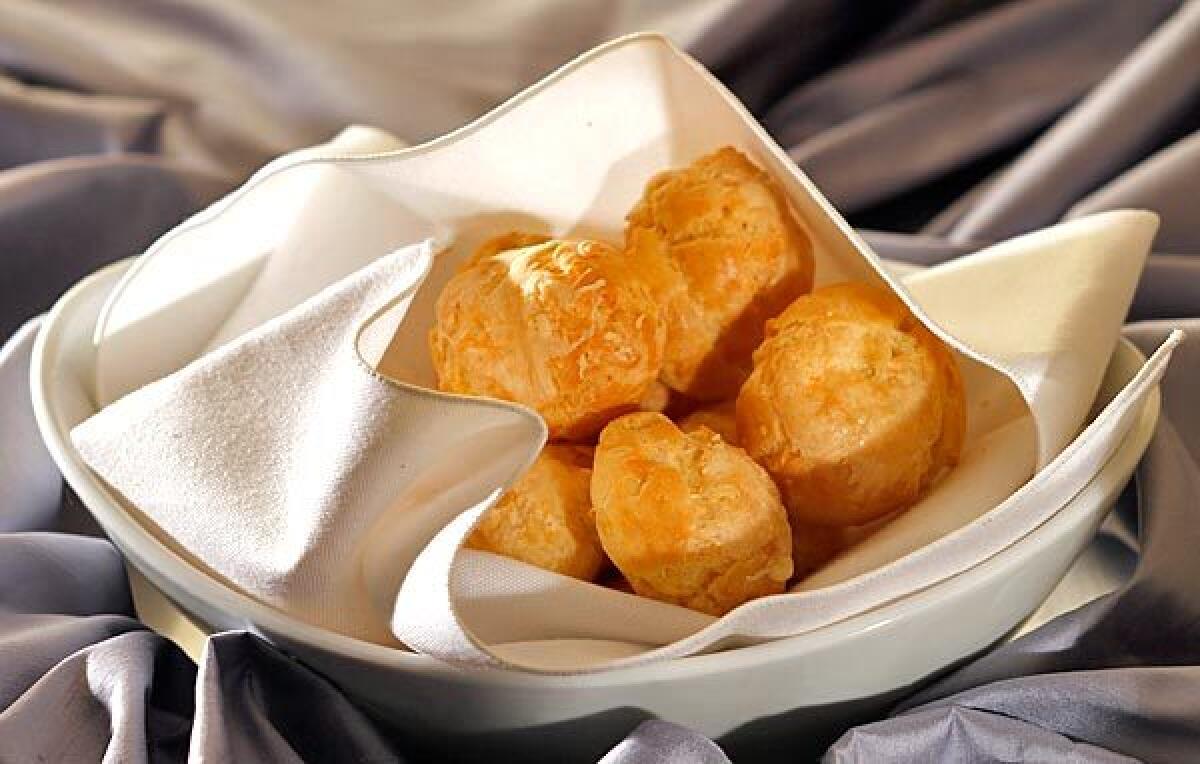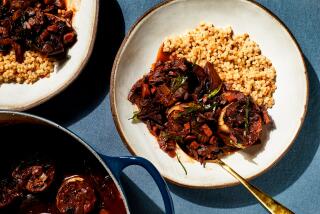The California Cook: <i>Gougères, </i>ready in a flash<i> </i>

As a cook, I am prone to enthusiasms and sometimes, perhaps more often than occasionally, they can be a bit excessive. I readily admit that. But, please, trust me on this one: Frozen gougères are the best thing Iâve discovered this year. No, really.
Doubt me? Think about this: a crisp, crusty savory cream puff, lighter than air but rich with the utterly irresistible fragrance of browned Gruyère cheese. And hereâs all you have to do to fix them: Remove from freezer; place on cookie sheet; bake for a half-hour. All of the hard work â making the dough, piping it into puffs â can be done well in advance.
Amazing. This could be to holiday entertaining what the discovery of electricity was to indoor lighting.
Never heard of gougères? Donât feel bad. Until relatively recently, they were one of those ultra-regional French specialties, a typical little bite in the bistros of Burgundy.
The first time I remember having them was at the French Laundry a decade or so ago. At this restaurant famous for perfecting the art of refined luxury, hereâs how a great meal starts: You gather at dusk on the patio in the garden. One waiter brings crystal flutes of a crisp rose Champagne. Then another brings gougères, swaddled in linen to preserve their fresh-from-the-oven warmth. A bite of crackling cheese puff, a sip of brisk bubbles, the shadows lengthen ⌠and now youâre ready for dinner.
Perfect, right? And until now perfectly out of reach. The gougères (pronounced GOO-zhair) from the French Laundry â and most other recipes for them â are made right before being served. And whereas at the French Laundry Thomas Keller has an army of cooks to take care of those kinds of things, at home Iâm pretty much on my own.
So while Iâve always regarded gougères as an ultimate appetizer, Iâve never gotten around to making them regularly. In the hour before a dinner party starts, Iâve got better things to do than beat cream puff paste.
But thanks to Dorie Greenspan, thatâs no longer necessary. While testing recipes from her splendid new book, âAround My French Table,â I noticed that she claims her recipe for gougères can be frozen before baking. You pipe out the cream puff dough in advance, freeze it on the cookie sheet, transfer it to a bag or box for long-term storage, and then pop it out whenever youâre ready. And she says they take only an extra four or five minutes to bake, straight from the freezer.
This seemed too good to be true. So I tried them, baking half of the puffs right away and then freezing the remainder (a typical recipe for gougères will make three to four dozen). The first batch was great, of course. But the real news was the next day when I put the leftovers from the freezer straight into a hot oven. Half an hour later, they were done. And they were perfect.
I was so excited I started e-mailing everyone I knew. Some of my correspondents were equally jazzed. Others, less so. My pal Michael Ruhlman, who co-wrote âThe French Laundry Cookbook,â among others, just said, âYou are such a geek.â
Yes, I replied to myself, but now Iâm a geek with gougères!
Still, I wasnât quite done. As good as Greenspanâs recipe for gougères is (and it is very good), I wanted to try some more. Would this freezing technique work with others?
So I gathered recipes from some of my favorite cookbook writers and went to work. A few pounds of flour and a couple of dozen eggs later, I can safely say that freezing does work with all of them (and, interestingly, by extension, it should work with other cream puff dough recipes as well ⌠perhaps an area for future exploration).
If youâve never made cream puffs at home, you really should give it a try. Once you get the hang of a couple of tricky steps, itâs really easy. You start by bringing water, butter and salt to a boil in a saucepan. Dump in a bunch of flour and start beating the mixture with a wooden spoon. Have all the ingredients measured and ready before you start, because this part goes very quickly.
At first, itâll look like a mess, but within 15 to 20 seconds the mixture will begin to come together to form a smooth, shiny, very resilient dough ball that pulls cleanly away from the sides and bottom of the pan. Keep cooking and stirring for a couple of minutes â you want to cook out as much of the water as you can to ensure the lightest, crispest puffs.
Transfer the dough to a stand mixer (itâll look like a thick paste, which is what professional bakers call it). Beat on medium speed for 20 to 30 seconds to cool it slightly. Then beat in the eggs, one at a time (with most recipes, Iâve found that you can add the eggs all together, but that proved problematic in a couple of instances, so I think itâs just safer to do it this way).
You can also mix all of this by hand, but youâd better have the shoulders of an NFL linebacker. That paste is dense.
When all the eggs have been fully incorporated, add the cheese. Thatâs just about it. The only thing thatâs left is forming the individual puffs. The easiest way to do this is with a pastry bag fitted with a three-eighths- to one-half-inch round nozzle. Youâll want to squeeze out roughly 1-tablespoon mounds, about the size of a small walnut. If you donât have a pastry bag, you can form the puffs with a soup spoon (wet it occasionally to keep the dough from sticking).
Form the balls on a cookie sheet lined with parchment paper or a silicone pastry sheet, so they donât stick. Now just put them in the freezer. Theyâll be frozen solid in a couple of hours, at which point you can transfer them to a tightly sealed plastic bag or food container for longer storage. (Theyâll keep for at least a few weeks.)
When youâre almost ready to serve, place as many of them as you want onto a lined cookie sheet and bake â first at high heat to get the puff and set the structure, then at lower heat to finish the interior. Thatâs all there is to it.
Cooking through several different recipes shows just how flexible the technique is. The basic ratio is roughly 1 cup of liquid to 1 cup of flour and 4 eggs. Butter can vary from 3 tablespoons (Judy Rodgersâ from âThe Zuni Cafe Cookbookâ are almost supernaturally light and crisp) to 7 tablespoons (from âThe French Laundry Cookbook,â which compensates with an extra quarter-cup of flour).
Most recipes call for water, though Greenspanâs uses half milk (it improves the browning). Noted teacher and cookbook writer Madeleine Kamman uses chicken stock (for a more rounded savory flavor). And, of course, you can experiment with different cheeses, using cheddar or Parmesan. I even read about one variation with blue cheese.
In the end, though, my tasters were unanimous and unequivocal in choosing the âFrench Laundryâ puffs as their favorites; they are light and crisp but have a profound, rich roasted cheese flavor.
Did I mention the most significant fact? All of this tasting took place during a weeknight dinner, after a long workday, while watching the Lakers on TV. With a green salad, it was a terrific light supper that required almost no effort at all.
Imagine that: gougères, once the ultimate luxury, now converted to a fast-food staple.
More to Read
Eat your way across L.A.
Get our weekly Tasting Notes newsletter for reviews, news and more.
You may occasionally receive promotional content from the Los Angeles Times.










